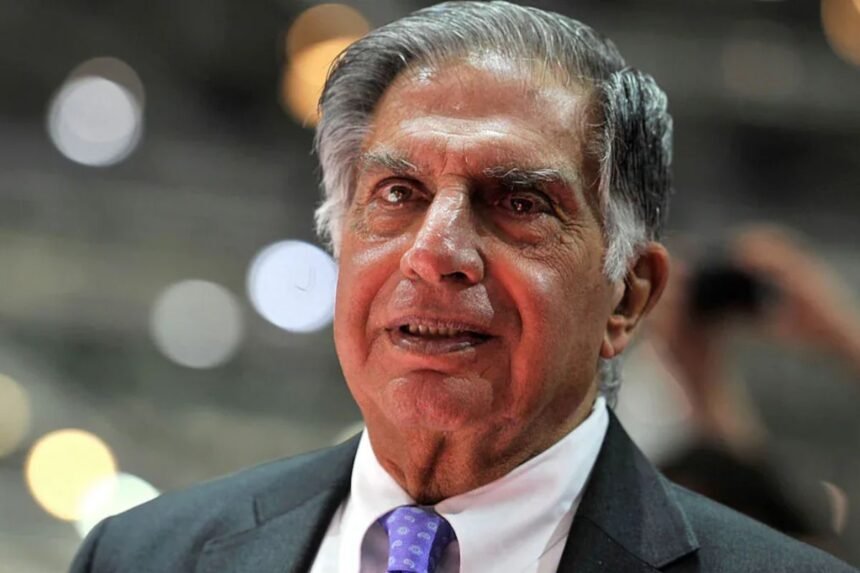Rata Tata Demise: The passing of Ratan Tata, the legendary industrialist, at the age of 86 has left an indelible mark on India’s industrial and social landscape. A man known for his business acumen and philanthropy, Tata’s deep-rooted emotional and professional connection to Jamshedpur, the city that grew alongside the Tata legacy, is one of the many aspects of his storied life.
This connection, spanning decades, traces back to his first visit to the city and continues through the transformative growth of Tata Steel and other ventures under the Tata Group.
Ratan Tata’s Passing and His Legacy
On a somber Wednesday, the 86-year-old Ratan Tata passed away in Mumbai’s Breach Candy Hospital after battling a prolonged illness.
His demise has triggered a wave of tributes from political leaders, industrialists, and citizens alike. Defense Minister Rajnath Singh expressed sorrow, referring to Tata as a “great hero of Indian industry.” Singh praised Tata’s invaluable contributions to the country’s economy, business, and industry, describing his departure as a significant loss.
However, one of the most profound tributes comes from Jamshedpur, the industrial hub that shares a deep-rooted history with the Tata family.
The city of Jamshedpur, also known as Tata Nagar, holds a special place in the Tata Group’s history, and Ratan Tata’s own bond with the city has been well-documented.
His personal relationship with Jamshedpur extends beyond business, marking a sentimental journey that began long before he assumed leadership of the Tata conglomerate.
Ratan Tata’s First Visit to Jamshedpur: A Reflection on His Journey
In July 2020, Ratan Tata shared an emotional Instagram post where he reminisced about his first visit to Jamshedpur.
His words painted a vivid picture of his early experience with the steel city, which would eventually become the nerve center of Tata’s industrial operations. Tata recounted how, during a college break, he had the opportunity to visit Jamshedpur.
He described how Mr. R.G. da Costa and Mr. J.D. Choksi invited him to tour the Telco (now Tata Motors) plant.
This visit, long before he took the helm of Tata Group, left a lasting impression on him. “I remember my first visit to Jamshedpur like it was yesterday,” Tata wrote in his post, expressing his deep appreciation for the warm welcome and the opportunity to witness the powerhouse of Indian industry at work.
The Birth of Tata Nagar: Jamsetji Tata’s Vision
To understand Ratan Tata’s emotional connection with Jamshedpur, one must trace the city’s origins back to the vision of his great-grandfather, Jamsetji Tata. In 1907, Jamsetji Tata laid the foundation for the Tata Iron and Steel Company, a project that would propel India into the global industrial arena.
He established a plant in the village of Sakchi, which would later grow into Jamshedpur.
By 1919, Lord Chelmsford, the then-Governor General of India, renamed the city “Jamshedpur” to honor Jamsetji Tata’s immense contributions to Indian industry.
The railway station at Kalimati was also renamed Tata Nagar, symbolizing the transformation of this small settlement into one of India’s most significant industrial centers.
The city’s name, Tata Nagar, signifies more than a geographic location, it reflects the lasting legacy of the Tata family and its deep ties with the region.
The emotional and business relationship between the Tatas and Jamshedpur is one that has evolved over generations, with Ratan Tata being a key figure in nurturing and expanding that legacy.
Ratan Tata’s Leadership: Cementing the Tata Legacy in Jamshedpur
Ratan Tata took over the reins of the Tata Group in 1991, and his leadership style was defined by innovation, vision, and an unwavering commitment to ethical business practices.
Under his guidance, Jamshedpur continued to flourish as the city evolved into an industrial powerhouse, driven primarily by Tata Steel.
Beyond the expansion of the Tata Group’s industrial ventures, Tata’s leadership was marked by his dedication to corporate social responsibility.
Tata Steel, under his watch, became a model for employee welfare and community development, significantly improving the quality of life in Jamshedpur. The city stands as a testament to Ratan Tata’s belief in the importance of nurturing not just industry but also the communities that support it.
Tata’s Acquisition of Air India: A Return to Legacy
One of Ratan Tata’s most celebrated moves in recent years was Tata Group’s acquisition of Air India in 2021, marking the return of the airline to the Tata fold after 68 years.
This move, although not directly related to Jamshedpur, highlighted Tata’s deep connection to Indian industry and its heritage.
Ratan Tata’s foresight and strategic planning allowed the Tata Group to continue its growth trajectory, and his ability to revive a debt-laden airline further cemented his status as a visionary leader.
His decision to re-acquire Air India was seen as a homage to J.R.D. Tata, the pioneer of Indian aviation and a key figure in the Tata legacy.
Key Milestones in Tata’s Journey with Jamshedpur
Several significant milestones have marked Ratan Tata’s journey with Jamshedpur and the broader Tata legacy.
His leadership extended beyond the steel industry, as he expanded Tata Group’s operations into automobiles, telecommunications, hospitality and more. Some of the most notable moments include:
These achievements, while global in nature, had deep roots in Jamshedpur, the city that stood at the heart of Tata’s industrial empire.
Public Tributes and Government Reactions
Following Ratan Tata’s passing, several government officials, industrialists, and public figures expressed their sorrow. Apart from Rajnath Singh, Prime Minister Narendra Modi called Tata’s passing “a monumental loss for India.”
Modi highlighted how Tata’s contributions had a lasting impact on India’s economic and social fabric. Similarly, numerous business leaders emphasized how Tata’s ethical leadership and vision for India’s industrial growth had inspired them.
The Emotional Legacy: Tata’s Connection to Jamshedpur
For the people of Jamshedpur, Tata’s death marks the end of an era. However, his emotional bond with the city remains timeless.
Jamshedpur’s identity is intertwined with the Tata family, and Ratan Tata’s deep affection for the city reflects the shared legacy of progress, innovation, and community development.
The Tata Group’s efforts to uplift the local community, enhance employee welfare, and contribute to the overall development of the region have left an indelible impact on Jamshedpur.
Ratan Tata’s personal connection to the city, expressed through his reflections on his first visit and subsequent interactions, showcases his commitment to the values his family has upheld for generations.
Conclusion: A Lasting Bond with Jamshedpur
As India mourns the loss of one of its greatest industrialists, the emotional and professional bond between Ratan Tata and Jamshedpur stands as a testament to the Tata legacy.
From Jamsetji Tata’s visionary dream to Ratan Tata’s global leadership, the city of Jamshedpur remains a symbol of progress and innovation.
Ratan Tata’s enduring connection with the city is a reminder of the profound impact he had on India’s industrial landscape and the lives of the people of Jamshedpur.
In his passing, Ratan Tata leaves behind a legacy that will continue to inspire future generations, both in Jamshedpur and beyond.
His contributions to Indian industry, his compassionate leadership, and his emotional bond with Jamshedpur are the hallmarks of a life well-lived.





